This Middle Eastern staple is well worth the minimal effort to make at home

These barely leavened breads, known to us by their Israeli name, but common throughout the Arab world, are some of the most ancient in existence. Although flat in appearance, they are designed to puff up during baking and then sink, creating a hollow interior that makes a handy repository for fillings. Quick to make, and easy to eat, its little wonder theyre popular, in various forms, from southern Europe to north Africa, not only for stuffing, but also as utensils for dipping or scooping food, and bulking out soups and salads.
Sealed in long-life packaging, pitta can be picked up at most supermarkets for mere pennies so why bother to make your own? Because, unless youre lucky enough to be able to find them freshly baked, shop-bought pitta is a very poor relation, just like pizza bases, or indeed hummus. The real thing is soft and chewy, rather than tough, with a fluffy interior perfect for soaking up sauces theyre well worth the pretty minimal effort.
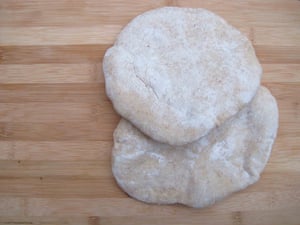
The flour
Most pitta recipes call for white flour, and generally of the high-protein, strong variety, although Yvonne Ruperti on the US-based Serious Eats website uses plain flour, both white and wholemeal, explaining that using 20% wholewheat flour [makes] the dough much more flavourful and nutty than one made with just all-purpose flour, while also not compromising its structure.
Pitta is a bread that depends on gluten development for its distinctive form; without it, the dough will not be strong enough to puff up in the oven, yielding a simple flatbread, rather than one with a pocket. (Pitta breads get their characteristic form from a combination of heat and moisture. When the thin round of dough goes into the oven, the heat sets the top and bottom while turning the liquid in the dough into steam, which is then trapped between these layers of cooked dough, causing the bread to expand. Although it will rapidly collapse when removed from the heat, the pocket inside remains intact.)
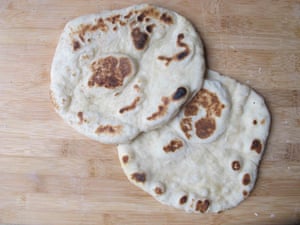
Most of Rupertis breads do rise (and fall), but I find the dough requires more initial kneading, and that the results lack the chewiness of some of the others. Belatedly, I realise that the American all-purpose flour she refers to tends to be harder than our own, so the difference between strong and plain flour over there will be less marked. In any case, British readers are best advised to splash out on bread flour.
The flavour and slightly nubbly texture that the wholemeal flour gives the breads is popular with testers, although as Ruperti notes, this doesnt produce gluten as easily as its white counterpart, so its best used in moderation. Strong wholemeal is ideal, but in such small amounts, plain will also do if thats what you have to hand. If you prefer a smoother, paler pitta, replace the wholewheat with more white flour.
The fat
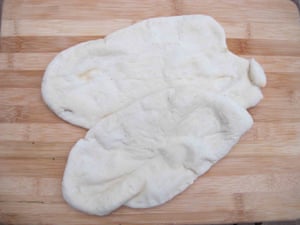
It is certainly possible to make pitta without any fat at all, although why you would want to is beyond me; not only does it add flavour, but it keeps the bread fresher for longer. Tom and Henry Herbert uses rapeseed oil in their book The Fabulous Baker Brothers, and Belinda Harleys Roast Lamb in the Olive Groves goes for butter instead, both of which work just fine texturally, but the former gives the bread a rich flavour that puts me more in mind of naan, while the latter is boringly neutral. Grassy and quintessentially Mediterranean, olive feels like the natural choice.
Sarit Packer and Itamar Srulovichs recipe in the Honey & Co cookbook, which several people recommend to me as the only one I should try, adds the fat towards the end of the kneading process. Although their pittas are delicious, its definitely harder to incorporate the oil at this point, and I would be interested to know the reason behind it; some research suggests that not adding it at the beginning encourages gluten formation in the dough. If anyone can confirm this, I would be grateful, but I dont find it makes a significant difference, so Im going to stick with the easier method.
Seasoning
You dont have to look very far to find recipes for flavoured pitta (garlic and thyme, for example, or black onion seed), but I dont think these little breads need any help in that department. That said, its common to add sugar to kickstart the action of the yeast, and although a pinch would be sufficient, using the same amount as salt gives the breads a more well-rounded flavour: add too much, as Ruperti does, and they lose the plainness that is their chief virtue; add too little, or none at all as the Herberts do, and theyre a bit underwhelming.
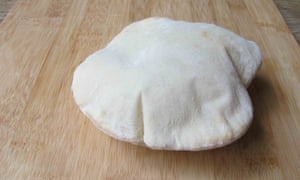
The method
Pitta dough must be sufficiently hydrated to generate steam when it meets the heat of the oven, and strong enough to trap this steam, and thus puff up, so the mixture must be both fairly wet and well-kneaded. Dont be tempted to flour the work surface unless the dough is so sticky as to be completely unmanageable; it will come together eventually and, in the meantime, a palette knife or dough scraper will make life easier. If you have a food mixer, then by all means use that; mines currently on the blink.
Packer and Srulovich recommend resting the dough overnight if you have the time, as it helps the flavour develop and makes the pitta fluffier, and theyre right; if homemade pittas are noticeably more delicious than shop-bought ones, slow-risen ones are even better.
Even if you cant wait that long, do let the individual breads rest before shaping; just 10 minutes makes the process much easier. The Herberts recommend rolling it out in one direction only, but this is another fiddly step I cant fathom the thinking behind as with the oil, if anyone knows why, please explain.
However you roll them out, make sure they are thin enough to puff up in the short time they take to cook, and evenly so, too, or they will blister in places, rather than blowing up like a balloon. Ruperti, who noticed a tendency for the pitta to end up with a much thinner top than bottom after it comes out of the oven, suggests flipping the breads over before putting them in the oven, so the pocket of air that rises during the final proofing stage is at the bottom when the dough enters the oven.
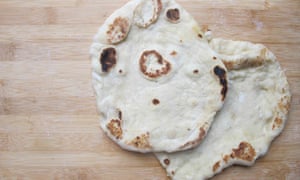
The cooking
Like most breads, pittas are traditionally baked at temperatures that can be difficult to replicate at home. Packer and Srulovich advise cranking your oven up to maximum, on the fan setting if possible, and heating a baking tray or stone along with it, to give the breads the hottest start possible and encourage the creation of steam.
Although the oven is certainly the best cooking option for pitta, as the heat from both top and bottom helps to set the dough quickly, its not the only one; Rebecca Seals book The Islands of Greece gives an excellent recipe using a frying pan. Harley also uses this method, which she recommends topping with a thick tomato sauce and crisp brown cubes of pork or lamb, a spoonful of thick tzatziki [and] some raw onion and tomato (pitta porn alert). The interior pockets are less reliable, but its much quicker if youre in a hurry, or its just too hot to switch the oven on.
Ruperti suggests finishing off the breads in a hot pan to give them that delicious charred flavour that can be hard to achieve in a domestic oven Not only do the pittas look a lot better that way, but the charring adds a layer of smoky flavour. Shes right, but it isnt traditional (Packer and Srulovich warn that they are not supposed to colour much) and it will crisp up the outsides of the breads, making them less pliable and amenable to stuffing. For me, it depends on what Ill be eating them with. Plainer fillings, such as hummus or salad, cry out for a little char, while barbecued meats or vegetables dont need it. The jury is out on my current favourite filling, however: Marmite and banana. In my defence, Ive had an awful lot of pitta to put away this week.

(makes 10)
400ml warm but not hot water
10g active dried yeast
2 tsp sugar
400g strong white flour
100g wholemeal flour (optional, or use 500g white)
2 tsp salt
2 tbsp olive oil, plus extra to grease
Put 100ml warm water in a jug and whisk in the yeast and half the sugar. Leave until the surface is covered in froth. Meanwhile, combine the flours, remaining sugar and salt in a large mixing bowl.
Mix the oil and yeasty water in the flour with your fingertips, then add just enough of the remaining water to give you a shaggy dough it should be soft, but not too sticky (note if youre using all white flour, it probably wont need as much as a wholemeal/white mix). Turn out on to a clean work surface and knead for about 10 minutes (or about 8 in a food mixer on a low speed) until smooth and elastic. Put into an oiled bowl, turn to coat in oil, then cover and refrigerate overnight, or leave somewhere warmish until doubled in size (about an hour to an hour and a half).
Heat the oven to maximum, preferably fan, with a baking stone or heavy baking tray in there. Meanwhile, divide the dough into approximately 80g balls, cover with a damp tea towel and allow to rest for 10 minutes, then roll out on a floured surface to rounds about 0.5mm thick, making sure they are evenly thick all over. Cover with a damp tea towel and leave for 20 minutes.
Operating as quickly as possible, put as many pitta as will comfortably fit on the hot stone or baking tray while its still in the oven, flipping them over as you pick them up, so the side resting on the work surface is now on top. Cook until they balloon, then carefully remove and keep warm in a tea towel while you cook the rest (how long this takes will depend on how hot your oven gets). Make sure to keep the oven door closed as much as possible to conserve heat. Eat the same day, or freeze.
Pitta, pide, khubz which version of this very versatile flatbread is your favourite, and how do you like to eat it? And has anyone had any success baking it with other flours?
Read more: https://www.theguardian.com/lifeandstyle/wordofmouth/2016/jul/13/how-to-cook-the-perfect-pitta-bread

